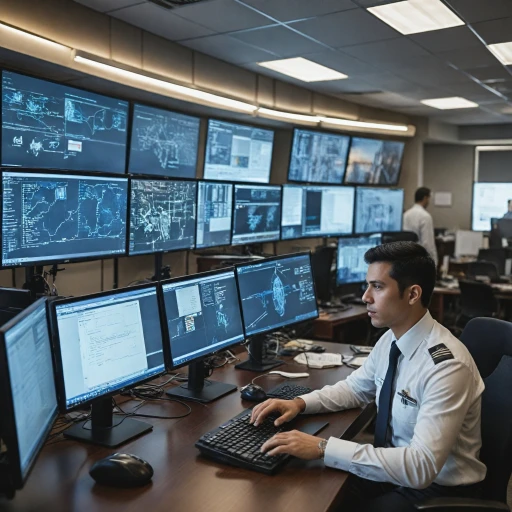
Embracing Innovation in Leadership
Fostering a Culture of Innovation
In today's rapidly evolving business landscape, enterprise leaders must embrace innovation as a core component of their leadership style. This involves cultivating an entrepreneurial mindset that encourages creativity and experimentation within the organization. By fostering a culture where new ideas are welcomed and explored, leaders can drive their teams to achieve greater success and maintain a competitive edge.
Encouraging Collaborative Efforts
Enterprise leadership is not just about individual brilliance; it’s about harnessing the collective capabilities of the team. Leaders should focus on building diverse teams that bring varied perspectives and skills to the table. This diversity can lead to more innovative solutions and enhance the organization's ability to adapt to change. By promoting collaboration, leaders can ensure that their teams are aligned with the company's strategic goals and are working towards a common vision.
Empowering Teams with the Right Tools
To truly embrace innovation, enterprise leaders must ensure that their teams have access to the necessary tools and resources. This includes investing in technology that supports strategic decision-making and enhances productivity. By leveraging technology effectively, leaders can streamline processes and enable their teams to focus on high-impact activities that drive the organization forward. For more insights on crafting effective strategies, you can explore crafting effective business-level strategies for the C-suite.
Developing an Enterprise Mindset
An enterprise mindset focuses on long-term success rather than short-term gains. Leaders must be willing to take calculated risks and make bold decisions that align with the organization's vision. This requires a deep understanding of the market dynamics and the ability to anticipate future trends. By developing an enterprise mindset, leaders can position their organizations for sustained growth and success in an ever-changing business environment.
Strategic Decision-Making in the C-Suite
Refined Decision-Making Frameworks
Within the intricate dynamics of the C-suite, strategic decision-making stands as a foundational pillar. An effective business-level strategy is essential to navigating complex situations with clarity and confidence. Decision-making at this level demands a nuanced understanding of internal and external factors that can influence outcomes.
Among the unique challenges enterprise leaders face is aligning decisions with the broader goals and vision of the organization. This requires an entrepreneurial mindset that focuses on innovation and adaptability. A leader's capability to anticipate and respond to market trends and business shifts is crucial, as the stakes are exceedingly high.
Utilizing Data-Driven Insights
In the realm of strategic decision-making, leveraging data becomes paramount. Leaders who harness comprehensive data not only gain insights into current performance but also enhance their foresight into potential future scenarios. This positions them to make informed decisions that drive the company towards sustained success.
Furthermore, enterprise-level leadership involves engaging teams and cultivating talent to extract valuable insights from data, transforming them into actionable strategies. By doing so, leaders develop an organization that remains resilient in the face of uncertainty and change.
Balancing Short-Term and Long-Term Goals
Enterprise leaders often grapple with the big question of balancing short-term and long-term objectives. Successful leaders craft decisions that address immediate needs without losing sight of the long-term strategic vision. This delicate balance requires a leadership style that is both entrepreneurial and pragmatic, ensuring that the organization remains agile and competitive.
By fostering an enterprise mindset, leaders can harmonize the diverse capabilities within their teams to navigate challenges effectively. This harmony not only supports tactical decision-making but also galvanizes the organization towards achieving its strategic goals.
Navigating Leadership Dynamics
Aligning Leadership Dynamics with Business Success
In the ever-evolving business landscape, enterprise leaders face the ongoing challenge of aligning their leadership dynamics with organizational success. An entrepreneurial approach to leadership plays a crucial role in this alignment, offering a framework to manage teams effectively while seizing business opportunities. The ability to foster collaboration within and across teams is a significant asset for any business organization. An enterprise mindset encourages leaders to break silos and work towards a common entrepreneurial goal. This ensures that different capabilities within the company are utilized to their full potential. By creating an environment where talent thrives, enterprise leadership drives the organization toward its strategic objectives. Utilizing the capabilities of an organization is closely linked to strategic decision making, a process that demands clear communication and understanding among leaders and their teams. Decisions must be data-driven yet flexible enough to accommodate dynamic market conditions. Developing an organization where strategic dialogues flourish ensures that entrepreneurial leaders are well-equipped to make informed and timely decisions, contributing significantly to organizational success. Furthermore, the art of leadership entrepreneurship involves navigating complex relationships within the leadership group itself. Leaders must cultivate an environment of trust, encouraging open communication and collaboration. By doing so, they nurture a cohesive leadership team, capable of addressing the big questions and steering the company towards sustained success. For those on the cusp of leadership transitions, successfully navigating the path to leadership is key to strengthening leadership dynamics (read more). Such navigation demands an insightful mindset focuses that can appreciate the subtleties of organizational dynamics and leverage them for long-term benefit. In summary, achieving alignment between leadership dynamics and business success is a multifaceted endeavor. It requires an enterprise leader to possess an acute awareness of how their leadership style influences company decisions and overall strategy. When executed effectively, entrepreneurial leadership not only propels the organization forward but also sets a solid foundation for future triumphs.Building Resilient Organizations
Strengthening Organizational Resilience for Sustained Success
In the ever-evolving landscape of enterprise leadership, building a resilient organization is critical for sustained success. At the core of such resilience lies a robust foundation shaped by effective leadership and an entrepreneurial spirit. Enterprise leaders must craft environments where innovation and adaptability are second nature, empowering teams to navigate and thrive amidst change. Resiliency at the enterprise level is anchored in a blend of foresight and strategic thinking. Leaders should focus on developing talent and capabilities that foster an adaptive mindset within the organization. This involves not only nurturing an entrepreneurial leadership style but also prioritizing the development of capabilities that enable the business to absorb shocks and pivot when necessary. To build an organization that endures challenges, focus on:- Empowering Your Teams: Develop an enterprise mindset that inspires individuals to take ownership of their work. By cultivating a culture where teams feel confident and supported, leaders can channel collective strengths towards common goals and transformative decision-making.
- Investing in Capabilities: Leverage your company's talents by identifying and nurturing skills crucial for innovation and problem-solving. Creating opportunities for continuous learning ensures the organization remains agile and well-prepared for future challenges.
- Promoting Effective Communication: Leaders must foster open channels of communication within the organization. Having a transparent flow of information enables quick, cohesive responses to emerging business challenges.
Leveraging Technology for Strategic Advantage
Gaining the Upper Hand with Technological Advancements
Enterprise leadership often involves weaving technological innovations into the fabric of everyday operations, ensuring that the organization remains ahead of the curve. Leveraging technology is more than just implementing new software or gadgets; it’s about strategic integration that aligns with the company’s broader objectives. Understanding the right technologies that fit the unique needs of your organisation can transform how your teams operate and collaborate. Leaders with an entrepreneurial mindset recognize that technology is a pivotal tool that can be harnessed to gain a competitive edge, enhance decision making capabilities, and streamline operations for improved efficiency. In evaluating potential technologies, leaders must consider:- Alignment: Does the technology align with our enterprise level goals?
- Adoption: How can we ensure seamless integration within existing processes? What training will our teams need?
- Innovation: Does the technology encourage or enable our teams to innovate and push boundaries?














